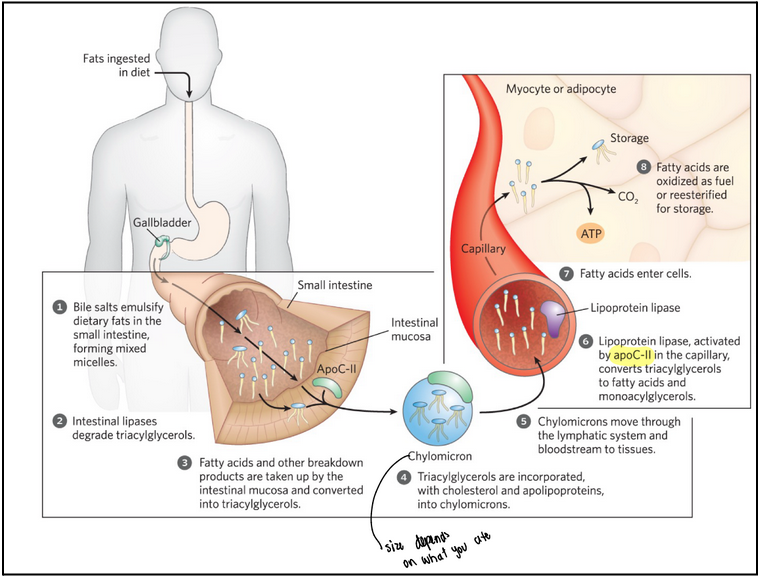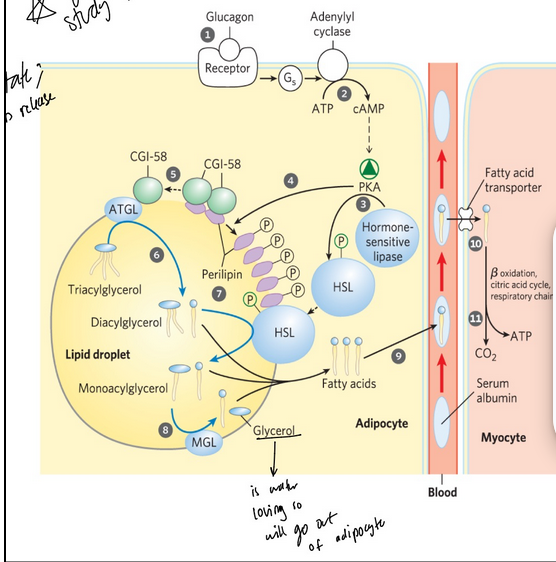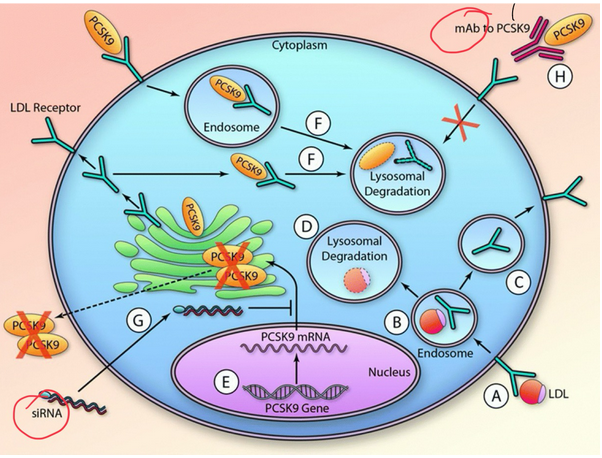Lipid trafficking and cholesterol (slide deck 3)
1/21
There's no tags or description
Looks like no tags are added yet.
Name | Mastery | Learn | Test | Matching | Spaced |
|---|
No study sessions yet.
22 Terms
dietary fats are abdorbed in
the small intestine
bile salts role in digestion
Bile salts emulsify dietary fats in the small intestine, forming mixed micelles
Bile acids synthesized in the liver and stored in the gall bladder
Triggered release when you eat fats
Cholesterol cannot emulsify fats since it is not amphipathic enough ie. not polar enough
Exogenous lipid trafficking steps
Fats ingested in diet
Bile salts emulsify dietary fats in the small intestine, forming mixed micelles
Intestinal lipases degrade triacylglycerols
Fatty acids and other breakdown products are taken up by the intestinal mucosa and converted into triacylglycerols
Triacylglycerols are incorporated, with cholesterol and apolipoproteins, into chylomicrons
Chylomicrons are synthesized from dietary fats in the ER of enterocytes (enterocytes in the small intestine assemble dietary triglycerides, cholesterol, and fat-soluble vitamins into chylomicrons. ApoB-48 is added in the ER)
Chylomicrons move through the lymphatic system and bloodstream to tissues
Lipoprotein lipase, activated by apoC-II (transferred to chylomicrons from HDL) in the capillary, converts triacylglycerols to free fatty acids and monoacylglycerols
Fatty acids enter cells
Fatty acids are oxidized as fuel (CO2 or ATP) or reesterified for storage (myocyte or adipocyte)
Chylomicron remnants move through the bloodstream to the liver
Receptors in the liver recognize and bind to the apoE in the remnants and mediate uptake of these remnants by endocytosis

chylomicrons
Chylomicrons are particles consisting of traicylglycerols, cholesterol, and apolipoproteins → the largest, and least dense of the lipoproteins contain a high percentage of TAGs.
Become larger and more abundant in response to increased fat intake because they package more dietary triglycerides into a single particle
Deliver fat to where it is needed
Apolipoproteins allow for traffic back to liver once completed
True or False: If you prevent the synthesis of bile acids, this will reduce the amount of dietary fat absorbed in the intestine + explain
True since dietary fat absorption requires bile acid
Why wouldn’t we want to make bile acid inhibitors though?
Bile acids play a crucial role in fat digestion, and by inhibiting them, you could cause malabsorption of not only fats but also fat-soluble vitamins (A, D, E, K)
Only way to naturally get rid of high cholesterol → ex. Oat fibre since there are no degradation pathways for cholesterol in humans
lipoproteins
Spherical aggregates of apoliproteins and lipids
Arranged with hydrophobic lipids at the core and hydrophilic protein side chains and lipid head groups at the surface
Various in densities depending on combinations of lipid and protein
Range from chylomicrons and very-low-density lipoproteins (VLDL) to very-high-density lipoproteins (VHDL)
apolipoprotein B-48 (apoB-48)
Primary protein component of chylomicrons
apolipoprotein C-II (apoC-II)
Protein picked up in the blood by chylomicrons from high-density lipoprotein (HDL) particles
It allows lipases to bind to extract fat
lipoprotein lipase
Extracellular enzyme in the capillaries of muscle and adipose tissue that hydrolyzes triacylglycerols to free fatty acids and monoacylglycerols
Activated by apoC-II
ultracentrifugation
Separates by size and density
Things will sediment quicker the more dense they are
Four major classes of human plasma lipoproteins
Different combinations of lipids and proteins produce particles of different densities
Size and density are inversely proportional
Can be separated by ultracentrifugation
Very-low-density lipoprotein (VLDL)
Lipoproteins that carry cholesteryl esters or triacylglycerols from the liver to muscle and adipose tissue
apoC-II activates lipoprotein lipase to release FFAs from traicylglycerols
Intermediate-density lipoprotein (IDL)
Lipoproteins that have donated some of their fatty acids to other cells for energy
Low-density lipoprotein (LDL)
“Bad” cholesterol involved in returning cholesterol to the liver which prevents cholesterol build up
Associated with risk of heart disease
High-density lipoprotein (HDL)
“Good” cholesterol are lipoprotein particles that are comprised predominantly of cholesterol
lipid transport is made possible by…
packing large numbers of fats into micelles that are complex with specialized proteins known as lipoproteins. The amount of fat stored in these particles and their associated lipoproteins defines what type of particle they are -- the less concentrated they are the denser they will be
Fatty acids can be extracted from these lipoprotein particles by lipases that bind to the lipoprotein apoC-II and cleave off free fatty acids for use in specific cells
the endogenous pathway
The pathway from VLDL formation in the liver to LDL return to the liver
Steps:
The liver synthesizes triglycerides and cholesterol. These lipids are packaged into VLDL (very-low-density lipoprotein) particles. apoB-100 is loaded onto VLDL as its structural protein.
VLDL enters the bloodstream. It acquires additional apolipoproteins (apoC-II, apoE) from HDL.
apoC-II activates lipoprotein lipase (LPL). LPL hydrolyzes triglycerides → free fatty acids (taken up for storage or energy) + glycerol (returned to liver).
After losing triglycerides, VLDL becomes IDL (intermediate-density lipoprotein). IDL can take two routes:
Cleared by the liver via apoE recognition.
Further metabolized by hepatic lipase to form LDL.
Formation of LDL: IDL loses more triglycerides and apolipoproteins → becomes LDL (low-density lipoprotein). LDL is cholesterol-rich, carrying mostly cholesteryl esters.
LDL delivers cholesterol to peripheral tissues for membrane synthesis, steroid hormone production, etc. Uptake occurs by LDL receptor (recognizes apoB-100) via receptor-mediated endocytosis.
Most LDL eventually returns to the liver, where it is taken up by LDL receptors. The excess cholesterol in these particles is either converted into bile acid for digestion or repackaged into a VLDL for circulation
consequence of variant that impairs function of the protein that loads Apo-B48 onto the surface of a chylomicron
messes up exogenous trafficking; micelle loses identity since you cannot load apo-B48 (involved in receptor mediated retrieval system), doesn’t know where to go and doesn’t know how to get back to liver
consequence of variant that impairs function of apo-CII
Activates lipoprotein lipase (LPL), which hydrolyzes triglycerides in chylomicrons and VLDL so that fatty acids can be taken up by muscle/adipose tissue. So this would cause Chylomicrons and VLDL to not be efficiently hydrolyzed.
consequence of variant that impairs function of phospholipid-particle associated lipases
similar to apo-CII, cannot breakdown TAGs
storage of excess fatty acids
Fatty acids are converted to TAGs in the liver
Fatty acid synthesis occurs in the cytoplasm of the liver after an excess of energy is consumed
TAGs are packaged with specific apolipoproteins into VLDLs
VLDLs are secreted and transported in the blood to adipose tissue
TAGs are removed and stored in lipid droplets within adipocytes in the adipose tissue
mobilization of triacylglycerols stored in adipose tissue
Mobilization occurs when hormones (glucagon and epinephrine) signal the need for metabolic energy
Glucagon is released when in fasting state
PKA (protein kinase A) triggers changes that open the lipid droplet to the action of three cytosolic lipases
Now have access to cleave TAGs
Lipid droplets = organelles stored in adipocytes and steroid-synthesizing cells that contain neutral lipids
Contain a core of triacylglycerols and sterol esters surrounded by a monolayer of phospholipids
Perilipins = family of proteins that coats the surface of lipid droplets to restrict access to lipid droplets
Prevent untimely lipid mobilization
Release of fats from adipocytes is tightly controlled and hormones stimulate lipases to release free fatty acids. FFAs are transported by albumin to target tissues for energy derived beta-oxidation

human serum albumin
Free fatty acids, FFAs = fatty acids released by lipases
Not happy free floating in aqueous solutions
Serum albumin = blood protein that noncovalently binds and transports FFAs to target tissues
Makes up about ½ of the total serum protein
Have 7 hydrophobic pockets
LNPs summary
Lipid nanoparticles allow for the transport of negatively charged nucleic acid polymers through the body to the target tissue (easiest ones currently are blood cells and liver)
Different structural lipids have distinct properties and propensities for forming lipid structures, these can be leveraged to carry different types of cargo
pH dependent ionizarion of structural lipid head groups enables the uptake of the nucleic acid, as well as release during endocytosis
We are using these particles in lots of interesting ways to deliver drugs and therapeutics
SiRNA therapies
siRNA targets PCSK9 mRNA in the nucleus/cytoplasm.
This reduces PCSK9 protein production.
Less PCSK9 → more LDL receptors recycled → lower LDL levels in blood.

which proteins would you target with siRNA to limit/restrict cholesterol synthesis? (SiRNA knocks down protein levels)
HMG-CoA reductase
PCSK9
Inhibit acetyl-CoA by inhibiting citrate lyase